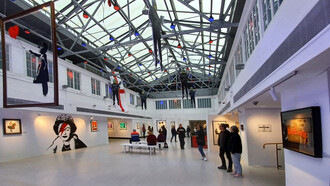In the midst of the glorious countryside of Emilia-Romagna stands a well-signposted but rather enigmatic compendium of buildings that comprises the physical accommodation for the Magnani Rocca Foundation. The Foundation has accommodated some serious temporary exhibitions in the past, but alas, I had always been seduced away by the stellar art attractions of the Venice Biennale, or Bologna, or Florence… well you get my drift. I have been kind of driving past Magnani Rocca for the past 5 years with a sense of, ‘I really must go and check this out’.
The prospect of 50 works on show at the foundation by Luciano Fontana finally proved to be the magnet strong enough to draw me in, and I have to say I was not disappointed, in fact, my expectations were exceeded on every count. Once one gets past the rather grim car park, the gardens and villa are simply stunning, I was serenaded into the villa itself by a number of shrieking pavoni (peacocks), which was both sweet and unnerving on the ears.
At the risk of teaching nonna to suck eggs, the Italian-Argentinian artist Fontana was one of the founding fathers of Spatialism (Spazialismo) whose post-war manifestoes (1947-53) professed that:
Matter, colour and sound in motion are the phenomena whose simultaneous development makes up the new art.
Fontana had a life and history far too long and eventful to narrate here, suffice to say that he was involved with the physical and artistic rehabilitation of post-war Italy, working with artists and architects.
He worked with art schools in Italy (Brera, La Sapienza) and Argentina (The Altamira Academy), and was one of the moving parts of a generation of artists that were desperately seeking to create new versions of themselves out of the legacy of rubble created by both the allies and the fascists.
But to the task in hand, yes the show. Well, it is spectacular and I felt I came away with a genuine insight into the time, the artist and his rare sensibility. I feel like I am writing this rather backwards, but the reason is that the words do not invite one to attach language or narrative in ways to which we have become accustomed.
If one takes the output as a starting point rather than the intent, the works are sumptuous in their materiality, exquisite in form and precise in execution. But it doesn’t end there - one cannot divorce the works from the image of the artist in the process of creation; works are stabbed, sliced, slashed, ripped, rent asunder and pierced with what must have been a heady combination of visceral violence and select punctuation. This is the elephant in the room, each work records and implicates the artists actions for posterity in ways that are perhaps unique to Fontana. I have simply never felt like this about any other work I have seen, perhaps with the exception of Rothko.
Over the past 30 years, I think I have come to expect that the art will deliver a vision and version of reality that one can narrate or decipher with a more-or-less post-modern or deductive diagnostic. This simply won’t wash with Fontana, his works tell you loudly at the point of contact exactly what has happened, they are direct testimony to the presence of the artist and what he has done, what has been enacted, and because of this I found myself completely occupied by the vision of the interaction of Fontana and the material in front of him. In other words, as a viewer, one finds oneself vicariously re-enacting and re-imagining the cause and effect required to create the work.
Sure, I know that lots of brilliant art historians have accounted for Fontana’s ‘eggs’, ‘holes’, and ‘mouths’, the special concepts, the layers, and the idea that destruction can be an act of creativity1, but standing with the work is a truly (meta)physical as well as intellectual process; a process in which one gets transported back in time through the portal of the work to the moment in the artist’s studio, and the point in the artist’s process that literally marked time.
Seeing the works in this show re-awakened in me a sense of optimism for making that I thought I had lost, or at least mislaid, given that artists, museums, biennale, etc., seem largely preoccupied with spectacle, scale, impact and image. Fontana at Magnani Rocca is a timely reminder that art is not only an end but also a means that can invite, intrigue and engage in ways that pure spectacle cannot. The spectacular is great to witness, but Fontana’s work allows us to testify as well as spectate, how amazing is that.
The works were kindly lent by the Lucio Fontana Foundation and the curatorial team at Magnani Rocca has done a splendid job or selecting, spacing and lighting the works on display. If your travels take you near Milan or Parma or Venice, then this is definitely worth a detour, but allow for 3 hours at least!
Notes
1 Fontana also attended the "Destruction Art, Destroy to Create" demonstration at the Finch College Museum of New York (1968).















